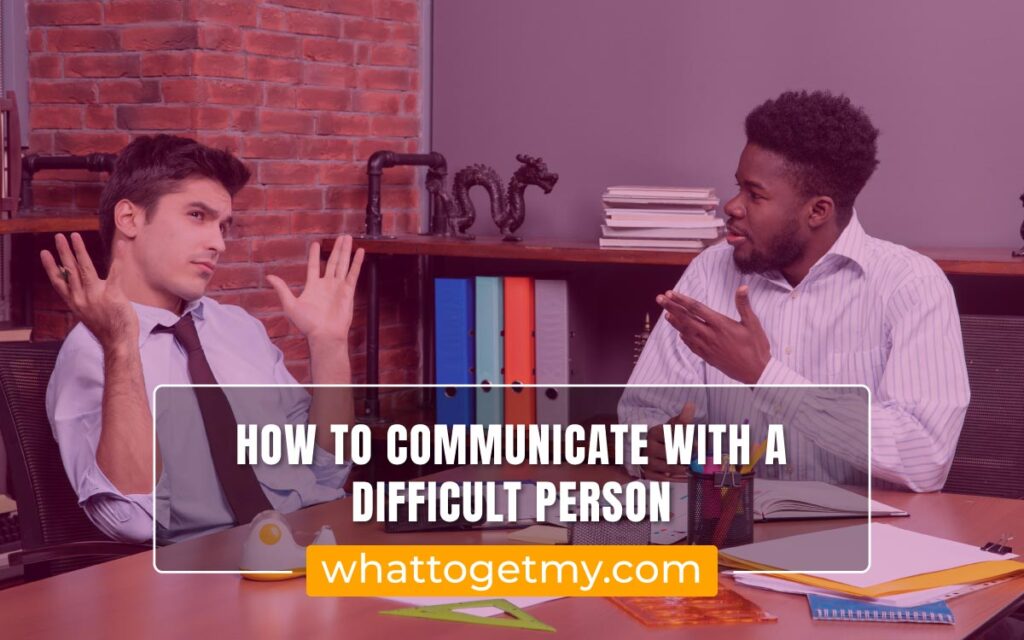5 Most Effective Tips On How to Communicate with a Difficult Person (2023)
Dealing with difficult people can be challenging, especially regarding communication.
Defensiveness is yet another trait exhibited by difficult personalities. When faced with criticism or differing opinions, they may become defensive, reacting with hostility or counterattacks.
Directing your attention to the speaker is essential to engage in active listening.
Asking open-ended questions can be a powerful way to encourage the speaker to share more and provide additional insights.
By actively listening with empathy, you demonstrate your commitment to understanding and validating the difficult person’s perspective.
Dealing with difficult people can be challenging, especially regarding communication. Whether it’s a demanding coworker, an argumentative family member, or an aggressive neighbor, learning how to communicate with a difficult person is essential for maintaining healthy relationships and minimizing conflicts. This article will explore various strategies for communicating with challenging people and effective communication techniques for difficult individuals. By implementing these strategies, you can develop vital communication skills and create more harmonious connections in your personal and professional life.
Understanding Difficult Personalities
Before diving into effective communication strategies, it’s essential to understand the characteristics and behaviors that make someone difficult to communicate with. Difficult people can exhibit stubbornness, aggressiveness, defensiveness, or a tendency to dominate conversations. They may have poor listening skills, lack empathy, or resist change. Recognizing these patterns can make how to talk to a difficult person easier and help you approach conversations with greater awareness and adaptability.
Understanding Difficult Personalities: Navigating Challenging Behaviors
In our interactions with others, we often encounter individuals with difficult personalities, making communication a daunting task—that’s where our tips for communicating with challenging individuals come in handy. Understanding the characteristics and behaviors commonly associated with difficult people is crucial for effectively engaging with them. Difficult individuals may exhibit various traits that can create barriers to effective communication.
Stubbornness is a trait commonly found in difficult personalities. These individuals tend to cling to their opinions and ideas, often resisting alternative viewpoints. Their inflexibility can make finding common ground challenging or reaching a compromise. Additionally, aggressiveness is another common characteristic, where difficult people may display aggressive behavior or use intimidating tactics to dominate conversations. Their aggressive approach can create tension and hinder open and productive communication.
Defensiveness is another trait exhibited by difficult personalities. When faced with criticism or differing opinions, they may become defensive, reacting with hostility or counterattacks. This is often a fear of being wrong or vulnerable. Understanding this insecurity can help you approach conversations with empathy and diffuse potential conflicts.
Poor listening skills are another hallmark of difficult individuals. They may interrupt frequently, disregard others’ perspectives, or focus solely on their agenda. This lack of active listening can create frustration and a sense of being unheard or undervalued. Furthermore, difficult people may struggle with empathy, challenging understanding, or relating to others’ emotions or experiences. Their limited capacity for empathy can hinder genuine connection and hinder effective communication.
Resistance to change is a common characteristic of difficult personalities. They may prefer to maintain the status quo and resist new ideas or alternative approaches. This resistance can make introducing necessary changes or exploring innovative solutions difficult. Recognizing this resistance can help you tailor your communication strategies to introduce and explain the benefits of change gradually.
Understanding these behavior patterns in difficult personalities allows you to approach conversations with heightened awareness and adaptability. Rather than taking their behavior personally, you can employ strategies that foster understanding, empathy, and effective communication. Building rapport with challenging individuals through communication and a foundation of empathy and flexibility can open doors to more meaningful and productive interactions with difficult individuals.
The survey above by Statista shows U.S. consumers’ preferred communication channels when dealing with a difficult customer service inquiry.
Active Listening: Engaging with Empathy
One of the fundamental skills in communicating with difficult individuals is active listening. Active listening involves fully engaging with the speaker verbally and nonverbally and demonstrating empathy. By actively listening, you show respect and understanding, which can help defuse tense situations, build rapport, and help you attain the goal of communicating effectively with difficult individuals. To actively listen, focus on the speaker, maintain eye contact, and provide verbal and nonverbal cues to indicate attentiveness. Avoid interrupting or jumping to conclusions, and instead, seek clarification and ask open-ended questions to gain deeper insights into their perspective.
Active Listening: Cultivating Empathy in Communication
Active listening is a powerful tool that can significantly enhance overcoming communication barriers with difficult individuals. It involves hearing the words, fully engaging with the speaker, and demonstrating empathy. By actively listening, you create an environment of respect, understanding, and validation, which can help defuse tense situations and build rapport.
Directing your attention to the speaker is essential to active listening. Maintain eye contact and use appropriate nonverbal cues, such as nodding or smiling, to signal your attentiveness. By doing so, you convey that their words are valuable and that you are genuinely interested in understanding their perspective.
Avoid the temptation to interrupt or interject with your thoughts or judgments. Let the speaker express themselves fully without interruption. Remember that active listening provides space for their voice to be heard.
To deepen your understanding, seek clarification when needed. Paraphrase the speaker’s words to ensure you have accurately understood their message. Reflecting their words to them shows that you are actively engaged in the conversation and committed to understanding their viewpoint.
Asking open-ended questions can be a powerful way to encourage the speaker to share more and provide additional insights. These questions cannot be answered with a simple “yes” or “no” and instead invite the speaker to elaborate and delve deeper into their thoughts and feelings. This helps to foster a more meaningful and open conversation.
Empathy plays a vital role in active listening. Put yourself in the speaker’s shoes and try understanding their emotions and experiences. This doesn’t mean you must agree with everything they say, but it allows you to acknowledge and validate their feelings. By showing empathy, you create an atmosphere of trust and support, which can foster a more constructive and fruitful dialogue.
By actively listening with empathy, you demonstrate your commitment to understanding and validating the difficult person’s perspective. This can pave the way for more effective communication, encouraging the speaker to feel heard, understood, and respected. Active listening builds bridges of empathy, allowing for more productive conversations and potential resolution of conflicts.
Using “I” Statements: Assertive Communication
Assertive communication is a powerful tool when interacting with difficult people. It involves expressing your thoughts, feelings, and needs clearly and respectfully without being passive or aggressive. One effective technique in assertive communication with difficult people is using “I” statements. These statements allow you to assert your position without sounding accusatory or confrontational. For example, instead of saying, “You always interrupt me,” rephrase it as “I feel frustrated when I’m interrupted.” This approach shifts the focus from blaming the other person to expressing your emotions and experiences. Using “I” statements encourages open dialogue and helps prevent the conversation from becoming defensive or argumentative.
The “I” Statements: A Key to Assertive Communication
Assertive communication is a valuable skill to employ when dealing with difficult individuals. It involves expressing your thoughts, feelings, and needs clearly and respectfully, striking a balance between passive and aggressive. One effective technique in assertive communication is using “I” statements, which can help you assert your position without sounding accusatory or confrontational.
When you use “I” statements, you take ownership of your emotions and experiences, allowing you to express yourself in a way that promotes understanding and avoids escalating conflict. Instead of pointing fingers or sweeping generalizations, “I” statements enable you to focus on your perspective and assert your needs without attacking or blaming the other person.
Using “I” statements also helps foster empathy and understanding in the communication process. By expressing your feelings and needs, you invite the other person to see things from your perspective and engage in a more empathetic and constructive conversation. This can promote mutual respect and increase the likelihood of finding a resolution or common ground.
When using “I” statements, being genuine and specific about your emotions and experiences is essential. Communicate how a particular behavior or situation impacts you personally. This allows the other person to gain insight into your feelings and better understand the consequences of their actions. In the process, improving communication skills when dealing with difficult individuals.
Remember, assertive communication is about advocating for yourself while respecting the rights and boundaries of others. Using “I” statements, you can assert your needs and express your emotions to promote understanding, mutual respect, and effective communication with difficult individuals.
Setting Boundaries: Establishing Clear Limits
Establishing boundaries is crucial when dealing with difficult individuals. Boundaries define what is acceptable and unacceptable behavior in your interactions. Setting clear limits protects your well-being and maintains a healthy relationship balance. Boundaries can encompass various aspects, such as time, personal space, emotional boundaries, and respectful communication. Communicate your boundaries assertively and firmly, emphasizing the importance of mutual respect. Be prepared for potential pushback or resistance, and consistently enforce your boundaries to establish trust and credibility.
Establishing Clear Limits for Healthy Interactions
When dealing with difficult individuals, setting boundaries is vital to maintaining your well-being and fostering healthy relationships. Boundaries act as guidelines that define what is acceptable and unacceptable behavior in your interactions. By establishing clear limits, you assert your needs and values, protect your emotional and mental well-being, and create a foundation for respectful communication.
Boundaries can encompass various aspects of your interactions with difficult individuals. It could involve setting limits on the time you spend together, defining personal space boundaries, or establishing emotional boundaries that safeguard your emotions and prevent manipulation. Effective boundary-setting requires assertiveness, firmness, and an emphasis on mutual respect and understanding.
Communicating your boundaries assertively is critical to understanding and respecting them. Use clear and direct language to express your limits, making it evident that you are setting these boundaries to prioritize your well-being and maintain healthy relationships. Emphasize the importance of mutual respect and explain how respecting boundaries can lead to more positive and productive interactions.
It’s important to anticipate potential pushback or resistance when setting boundaries with difficult individuals. They may test your boundaries or try to exploit the situation. Stay firm and consistent in upholding your boundaries, as this helps establish trust and credibility. Consistency shows that you are committed to maintaining your boundaries and conveys that certain behaviors are unacceptable.
Remember that setting boundaries is not about controlling or dismissing others’ needs but creating a healthy balance and fostering respect in your relationships. Setting clear limits establishes a framework for healthier interactions, protects your well-being, and creates an environment that promotes understanding and mutual respect with difficult individuals.
Managing Emotions: Emotional Regulation Techniques
Interacting with difficult people can evoke strong emotions, hindering effective communication. It’s important to develop emotional regulation techniques to manage these intense feelings. Take deep breaths to calm yourself, practice mindfulness, or engage in activities that help you relax and center your thoughts. Recognize your triggers and learn to detach emotionally from the situation to maintain objectivity. By managing your emotions, you can respond more composedly and constructively, creating a conducive environment for effective communication.
Cultivating Emotional Regulation for Constructive Communication
Engaging with difficult people often stirs up strong emotions that can impede effective communication. To navigate such situations more efficiently, you must develop emotional regulation techniques to help you manage these intense feelings. By cultivating emotional awareness and employing strategies for self-regulation, you can maintain composure and objectivity and engage in more constructive interactions.
When faced with challenging individuals, it can be beneficial to practice deep breathing exercises. Taking deep, intentional breaths helps calm your nervous system, reduce stress, and restore balance. Additionally, incorporating mindfulness techniques into your daily routine can enhance your ability to stay present and grounded amid emotionally charged encounters. Mindfulness involves being fully aware of your thoughts, feelings, and sensations without judgment, allowing you to respond rather than react impulsively.
Recognizing your triggers is crucial in managing your emotions during interactions with difficult people. Take the time to identify specific situations, words, or actions that evoke strong emotional responses in you. Once you have identified these triggers, consciously detach yourself emotionally from the situation. By creating a mental space between yourself and the challenging individual, you can gain perspective and respond more objectively, reducing the likelihood of escalating tensions.
Engaging in activities that promote relaxation and self-care is another effective way to manage your emotions. Find healthy outlets that help you decompress and recharge, such as engaging in physical exercise, spending time in nature, practicing hobbies, or seeking support from trusted friends or professionals. Taking care of your emotional well-being is essential in navigating difficult interactions without compromising your mental health.
By managing your emotions, you can approach conversations with difficult people more composedly and constructively. Cultivating emotional regulation techniques allows you to maintain control over your reactions, create a more conducive environment for communication, and increase the likelihood of reaching resolutions or finding common ground. Remember, by staying centered and regulating your emotions, you empower yourself to engage in healthier, more productive interactions with difficult individuals.
Conflict Resolution: Finding Common Ground
Difficult people often thrive on conflict, and disagreements can quickly escalate into heated arguments. However, conflict resolution skills can help you navigate these challenging situations and find common ground. Focus on understanding the underlying interests and motivations of the other person rather than engaging in a battle of wills. Seek areas of agreement and work towards a compromise that addresses both parties’ needs. Active listening, empathy, and a willingness to collaborate are essential in resolving conflicts with difficult people through effective communication.
Building Bridges and Finding Common Ground
Conflicts may arise when dealing with difficult individuals, and it’s essential to develop practical conflict-resolution skills to navigate these challenging situations. By focusing on understanding the underlying interests and motivations of the other person, you can find common ground and work towards mutually agreeable solutions. Employing active listening, empathy, and a collaborative mindset can foster constructive dialogue and facilitate conflict resolution.
Active listening plays a pivotal role in resolving conflicts with difficult individuals. It involves giving your full attention to the other person, not just their words but also their emotions and nonverbal cues. By actively listening, you demonstrate respect and a genuine desire to understand their perspective. Avoid interrupting or jumping to conclusions. Instead, ask open-ended questions to delve deeper into their interests and concerns. This approach fosters a sense of trust and openness, laying the foundation for finding common ground.
Empathy is a powerful tool in conflict resolution. Put yourself in the other person’s shoes and try to understand their emotions, needs, and challenges. Recognizing their perspective does not mean you have to agree with them, but it helps create an environment of understanding and respect. Acknowledging their feelings and validating their experiences can establish rapport and create a safe space for productive communication.
Approaching conflicts with a collaborative mindset promotes problem-solving and cooperation. Instead of engaging in a power struggle or seeking to “win” the argument, focus on finding mutually beneficial solutions. Look for areas of agreement and identify shared goals or interests. By shifting the focus from a win-lose dynamic to a win-win approach, you can foster a sense of cooperation and build a foundation for resolving conflicts.
It’s important to remember that conflict resolution with difficult individuals may require patience and perseverance. Some individuals may need help finding common ground or are unwilling to engage in constructive dialogue. In such cases, it may be necessary to disengage temporarily, seek mediation or professional support, or establish clear boundaries to protect your well-being. Remember, conflict resolution is a process that may take time to find resolutions or reach agreements. Stay committed to open communication, empathy, and a collaborative mindset, and you’ll increase the chances of finding common ground and resolving conflicts with difficult individuals.
Effective conflict resolution techniques enable you to navigate challenging interactions with difficult individuals more effectively. You create an environment that encourages constructive dialogue and problem-solving by listening actively, demonstrating empathy, and fostering collaboration. Ultimately, the goal is to find common ground and reach resolutions that address the needs and interests of all parties involved.
Frequently Asked Questions:
1. Q: How can I communicate effectively with a difficult person who often interrupts me?
A: When dealing with a difficult person who frequently interrupts, assertively communicating your need for uninterrupted conversation is essential. Use “I” statements to express your feelings and frustrations, such as “I would appreciate it if you let me finish speaking before responding.” Additionally, setting clear boundaries and gently reminding the person of your expectations can help foster more respectful communication.
2. Q: What should I do if a difficult person becomes defensive during a conversation?
A: Defensiveness is a typical response from difficult individuals when confronted or challenged. It’s crucial to stay calm and avoid escalating the tension to handle this situation. Maintain a non-confrontational tone and emphasize your desire to find a resolution or understand their perspective. Active listening and asking open-ended questions encourage people to express themselves more openly and may help diffuse their defensiveness.
3. Q: How can I handle a difficult person who always seems to dominate conversations?
A: Dealing with someone who dominates conversations can be challenging, but there are strategies you can employ. Firstly, establish assertive communication by expressing your need for equal participation in the discussion. Interrupt politely and ask for others’ input to balance the conversation. Additionally, redirect the conversation by bringing in relevant topics or involving other participants. It may also be helpful to have a private conversation with the person, addressing their dominating behavior and proposing a more inclusive communication style for future interactions.
Remember, each situation with a difficult person is unique, and it’s essential to adapt these strategies to suit your specific circumstances. Patience, persistence, and respect are essential when communicating with difficult individuals.
Conclusion
In conclusion, it is clear that effectively communicating with difficult people is a skill that can be developed through practice and patience. By employing strategies such as active listening, assertive communication, setting boundaries, managing emotions, and resolving conflicts, you can enhance your communication skills and navigate challenging interactions more successfully. Effective communication is a two-way street; approaching conversations with empathy, respect, and an open mind is vital. Applying the strategies discussed in this article can build healthier relationships, improve understanding, and create more positive interactions with difficult people.
03 HOURS 58 MINUTES
ESTIMATED TIME DESIGNING AND UPLOADING THIS ARTICLE
08 HOURS 48 MINUTES
ESTIMATED TIME RESEARCHING AND WRITING THIS ARTICLE
LOOKING FOR MORE GIFTS?
Try our AMAZING GIFT FINDER TOOL! Find GIFTS with 1 CLICK!
LOOKING FOR MORE GIFTS?
Try our AMAZING GIFT FINDER TOOL! Find GIFTS with 1 CLICK!
LOOKING FOR MORE GIFTS?
Try our AMAZING GIFT FINDER TOOL! Find GIFTS with 1 CLICK!
You Might Also Like

How to Send a Gift Anonymously
How to Send a Gift Anonymously WhatToGetMy Instructional Article It’s important to show how much someone means to you or demonstrate that you have been thinking about them by sending them a gift. If you are the type of person who likes sending gifts, chances

15 Insightful Ways To Save Your Daughter From A Bad Marriage
15 Insightful Ways To Save Your Daughter From A Bad Marriage WhatToGetMy Instructional Article Every parent with a daughter dreams of her growing up to have a fruitful and happy life, and marriage is usually a big part of this. When daughters end up in

29 Signs Of Insecurity In A Woman
Signs Of Insecurity In A Woman WhatToGetMy Instructional Article Insecurity in relationships always causes problems for the partners. In this article, we discuss what makes a woman insecure in a relationship, as well as 29 signs of insecurity in a woman that would tell you

How To Send Money On PayPal To Friends And Family – 5 Important Things To Know
How To Send Money On PayPal To Friends And Family – 5 Important Things To Know WhatToGetMy Instructional Article We might need to send money to friends and family for various reasons ranging from graduation gifts to contributions for dinner when the bill is split.

29 Perfect Gifts For Someone Who Hates Everything
A person who hates everything could have one or several reasons for hating everything. It could be because they are just angry people, or that they don’t like gifts, or they don’t know what they want or they have everything. The key to choosing the
Where to Rest Your Head in Salzburg: The Ultimate Neighborhood Guide
Where to Rest Your Head in Salzburg: The Ultimate Neighborhood Guide Planning a trip to Austria’s musical wonderland? Let’s figure out exactly where you should unpack your suitcase! Picture narrow cobblestone streets where Mozart probably spilled his coffee rushing to a concert—that’s Altstadt for you! This maze of medieval buildings and hidden courtyards feels like

13 Thoughtful Gifts for Aspiring Designers
Fashion designers are responsible for designing and illustrating fashion pieces; this could be clothing, shoes, or any other accessories. Aspiring fashion designers have a lot more work on their plate because they lack the funds to outsource some of the work such as patternmaking and

HOW TO THROW A TEA PARTY WhatToGetMy Instructional Article What comes to mind when you think of tea parties? Little girls in puffy pink dresses sitting in their backyards drinking tea with their make-believe friends, that one scene from The Great Gatsby, and those scenes

Why Does My Mom Compare Me To Others – 13 Reasons Why You Get Compared And What To Do About It
Parents comparing their children to other children has been done for millennia. And honestly, saying that parents have been doing this since the dawn of man is probably not very far from the truth. But why do we do it? Why do we feel the

15 Signs of a Lazy Man (Husband) and 9 Ways How to Deal with a Lazy Husband.
15 Signs of a Lazy Man (Husband) and 9 Ways How to Deal with a Lazy Husband. WhatToGetMy Instructional Article A lazy man will drain and suck the life out of a relationship because he will bring the same lazy, lackluster disposition he has into



